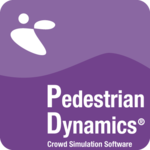Description

Pedestrian Dynamics

Simile
Comprehensive Overview: Pedestrian Dynamics vs Simile
Pedestrian Dynamics and Simile are software tools used in different contexts but share the common goal of modeling and simulation.
Pedestrian Dynamics
a) Primary Functions and Target Markets:
-
Primary Functions:
- Pedestrian Dynamics is primarily used for simulating and modeling pedestrian movement in various environments.
- It is designed to optimize the design and operation of infrastructures like shopping centers, transportation hubs, sports arenas, and any area where large numbers of people gather.
- The software helps in understanding crowd behavior, evacuation scenarios, and optimizing space utilization.
-
Target Markets:
- Urban planners and architects.
- Event organizers and facility managers.
- Transport authorities and safety consultants.
b) Market Share and User Base:
- Pedestrian Dynamics is a specialized tool within the niche market of pedestrian simulation and crowd management.
- While it may not have a large market share like more general business software, it is well-regarded within its specific industry.
- Its user base mainly includes professionals requiring detailed pedestrian flow analysis.
c) Key Differentiating Factors:
- The real-time analysis capabilities for dynamic crowd management.
- Detailed visualization, including 3D representations of the pedestrian flow.
- Versatile use cases that range from architecture to public safety.
Simile
a) Primary Functions and Target Markets:
-
Primary Functions:
- Simile is a software tool for system dynamics modeling and simulation, focusing on ecological and agricultural systems.
- It is used to create models that represent complex systems with many interacting components and is ideal for simulating environmental changes and biological systems.
-
Target Markets:
- Researchers and scientists in ecology and agriculture.
- Educational institutions for teaching complex system dynamics.
- Environmental consultants and policy makers.
b) Market Share and User Base:
- Simile is well-known in the niche market of scientific modeling, particularly in ecology and environmental science.
- It is widely used in academia and research but has a smaller market share compared to general-purpose modeling software.
c) Key Differentiating Factors:
- Specialized focus on ecological and biological systems, offering tailored features for these areas.
- Strong visual programming environment to facilitate user interaction with model components.
- Ability to handle complex systems with many interacting entities and feedback loops.
Comparison
-
Overall Market Share and User Base:
- Both Pedestrian Dynamics and Simile serve niche markets with specialized needs.
- Neither has a large market share compared to mass-market software, but both are respected within their specific domains.
-
Differentiating Factors:
- Pedestrian Dynamics stands out with its focus on pedestrian movement and crowd management.
- Simile differentiates itself with its focus on system dynamics modeling, specifically in ecology and agriculture.
- The key factor is the domain specialization, with Pedestrian Dynamics leaning towards urban spaces and Simile towards natural systems.
In conclusion, Pedestrian Dynamics and Simile cater to distinct markets with unique needs, making them valuable tools for professionals within their respective fields. While they might not command large market shares, their specialized functions and capabilities are critical for their specific user bases.
Contact Info

Year founded :
Not Available
Not Available
Not Available
Not Available
Not Available

Year founded :
2019
Not Available
Not Available
United States
Not Available
Feature Similarity Breakdown: Pedestrian Dynamics, Simile
Pedestrian Dynamics and Simile are both sophisticated tools used for simulation modeling, but they cater to slightly different domains and functionalities, so it is important to understand their core features, interface design, and unique aspects.
a) Core Features in Common
-
Simulation Modeling: Both tools support simulation modeling, allowing users to replicate real-world dynamic systems to study pedestrian behavior (Pedestrian Dynamics) or broader system behavior (Simile).
-
Visualization: They offer visualization capabilities to represent the simulation results, although Pedestrian Dynamics focuses more on pedestrian flow and crowd management, whereas Simile is often used for complex system modeling.
-
Scenario Analysis: Both allow users to set up and analyze different scenarios to study various phenomena under different conditions.
-
User Programming/Customization: Both solutions support user input to customize models. Simile often allows for more programming flexibility for complex systems.
-
Result Analysis: Tools for analyzing the results of simulations are available, helping users make informed decisions based on the data.
b) User Interface Comparison
-
Pedestrian Dynamics: Typically offers a user-friendly interface that is tailored towards ease of use for users focusing on pedestrian flow. It often includes drag-and-drop features for setting up simulations involving large numbers of individuals and visual tools to tweak the environment such as obstacles and pathways.
-
Simile: Its interface is more oriented towards complex systemic modeling, with a steeper learning curve. It uses a visual programming approach to build models, which can be both intuitive and powerful, but may require more upfront understanding of system dynamics concepts.
c) Unique Features
-
Pedestrian Dynamics:
- Specialized Pedestrian Flow Analysis: Its core strength lies in detailed pedestrian dynamics modeling, including features for emergency evacuation simulations, crowd control, and capacity analysis for infrastructures like train stations and stadiums.
- Realistic Movement Algorithms: Offers sophisticated movement algorithms that provide realistic pedestrian behavior predictions.
-
Simile:
- Generic System Modeling: While it can model pedestrian flows, its primary strength is in its ability to model various types of systems, including ecological, economic, and environmental systems.
- Customization and Complexity: Allows users to model highly complex systems with a high degree of customization, more suited to users with specific and varied system modeling needs.
In summary, while both Pedestrian Dynamics and Simile offer simulation modeling capabilities, they serve different niches and user needs, highlighted by their core features, varying interface designs, and unique attributes. Pedestrian Dynamics is well-suited for detailed pedestrian traffic and emergency simulations, while Simile caters to broader system dynamics with its flexible and customizable modeling capabilities.
Features

Not Available

Not Available
Best Fit Use Cases: Pedestrian Dynamics, Simile
Pedestrian Dynamics and Simile are both sophisticated simulation tools, but they cater to different types of projects and industries. Here’s a breakdown of their best-fit use cases and how they cater to different business scenarios and industry verticals:
Pedestrian Dynamics
a) For what types of businesses or projects is Pedestrian Dynamics the best choice?
- Urban Planning and Architecture: Pedestrian Dynamics is ideal for architects and urban planners who need to design and optimize public spaces such as parks, city centers, and pedestrian pathways. It helps simulate foot traffic and evaluate various design alternatives for efficiency and safety.
- Transport Infrastructure: Businesses involved in the development and management of transportation hubs, such as airports, train stations, and subways, benefit greatly from pedestrian simulation to improve crowd management, flow, and overall traveler experience.
- Event Management and Facility Operations: This tool is perfect for event organizers and venue operators, such as stadiums, convention centers, and amusement parks, where understanding and managing large crowds is crucial for safety and user experience.
- Retail and Commercial Spaces: For retailers, especially those managing malls or large shopping complexes, understanding pedestrian flow can aid in optimizing layout and increasing foot traffic, customer satisfaction, and sales.
Simile
b) In what scenarios would Simile be the preferred option?
- Ecological and Environmental Modeling: Simile excels in simulating complex ecological systems, making it a great choice for researchers and organizations working in the fields of ecology, environmental science, and agriculture who need to model ecosystems, agricultural landscapes, or environmental impacts.
- System Dynamics and Scientific Research: This tool is suited for academics and scientists engaged in dynamic systems research, as it provides robust modeling capabilities for various scientific disciplines, including biology and environmental sciences.
- Policy and Social Systems Analysis: Government agencies and NGOs studying policy impacts on systems such as public health, economics, or social infrastructures can leverage Simile to model scenarios and forecast potential outcomes of policy changes or interventions.
How do these products cater to different industry verticals or company sizes?
-
Pedestrian Dynamics generally caters to mid to large enterprises and public sector entities due to the scale of projects it is used for. These could be large architectural firms, city planning departments, major transportation authorities, or large events and entertainment enterprises. The nature of these projects often requires substantial investment both in software and in the personnel who can effectively utilize these tools.
-
Simile, on the other hand, often finds its niche within academia, research institutions, and smaller consultancy firms due to its focus on ecological systems and scientific modeling. It caters to a wide range of company sizes, from small non-profits studying environmental impacts to large governmental research bodies. Its utility for policy and educational sectors makes it versatile across different scales.
Both tools excel in their specific domains, offering specialized features and capabilities that address the unique challenges and objectives of their respective users.
Pricing

Pricing Not Available

Pricing Not Available
Metrics History
Metrics History
Comparing undefined across companies
Conclusion & Final Verdict: Pedestrian Dynamics vs Simile
To provide a comprehensive conclusion and final verdict for Pedestrian Dynamics and Simile, let's evaluate these products based on several factors such as features, usability, pricing, and targeted user base.
a) Best Overall Value:
Considering all factors, Pedestrian Dynamics offers the best overall value for users focused on detailed and specialized pedestrian simulation and analysis, such as urban planners or event organizers. Its robust features tailored for crowd simulation make it a standout choice for those specific needs. On the other hand, Simile, with its focus on system dynamics and agent-based modeling, provides significant value to users who need a versatile tool for broader environmental or social simulations, making it more suitable for academic or research contexts.
b) Pros and Cons:
Pedestrian Dynamics:
-
Pros:
- Highly specialized for pedestrian and crowd movement modeling.
- User-friendly interfaces tailored for quick scenario setup.
- Strong visualization capabilities for effective presentation and analysis.
- Reliable support for complex simulations such as emergency evacuations.
-
Cons:
- May have a steeper learning curve for users new to pedestrian simulation.
- Potentially higher cost for licenses compared to more general simulation tools.
- Narrow focus on pedestrian modeling might limit versatility for other simulation needs.
Simile:
-
Pros:
- Versatile modeling capabilities suitable for a range of applications beyond pedestrian dynamics, including ecological and socio-economic modeling.
- Supports both system dynamics and agent-based modeling.
- Offers an intuitive interface that is user-friendly for model development and testing.
- More cost-effective for users requiring general-purpose simulation tools.
-
Cons:
- May lack the depth of specialized features present in Pedestrian Dynamics for crowd-specific simulations.
- Might require additional customization for highly detailed pedestrian scenarios.
c) Recommendations:
For users trying to decide between Pedestrian Dynamics and Simile, it is essential to assess the primary goals of their simulations:
-
If the focus is predominantly on pedestrian crowd management, events planning, or urban infrastructure development where precise behavior modeling and evacuation scenarios are key, Pedestrian Dynamics is the recommended choice.
-
For users involved in research or scenarios that require a blend of system dynamics and agent-based approaches, particularly in fields like ecology, social systems, or broad economic modeling, Simile is more suitable due to its flexibility and broader applicability.
Ultimately, the decision should be aligned with the specific needs and objectives of the user's projects, considering both current requirements and potential future applications.
Add to compare
Add similar companies



